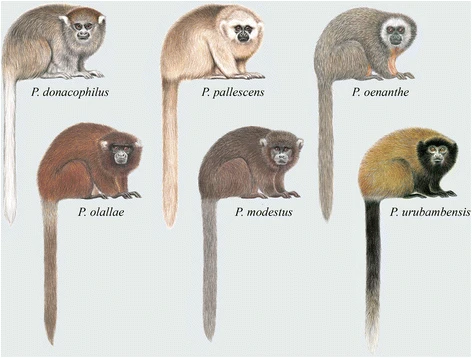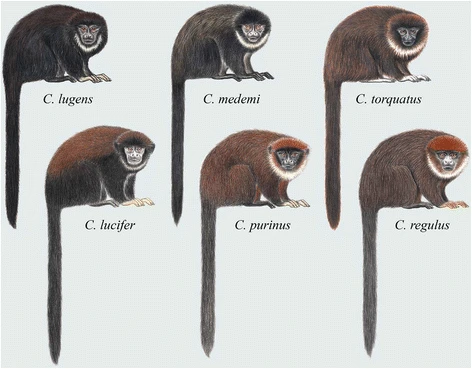|
Pitheciidae
The Pitheciidae () are one of the five families of New World monkeys now recognised. Formerly, they were included in the family Atelidae. The family includes the titis, saki monkeys and uakaris. Most species are native to the Amazon region of Brazil, with some being found from Colombia in the north to Bolivia in the south. Characteristics Pitheciids are small to medium-sized monkeys, ranging from 23 cm in head-body length for the smaller titis, to 44–49 cm for the uakaris. They have medium to long fur, in a wide range of colors, often with contrasting patches, especially on the face. They are diurnal and arboreal animals, found in tropical forests from low-lying swamp to mountain slopes. They are predominantly herbivorous, eating mostly fruit and seeds, although some species will also eat a small number of insects. Sakis and uakaris have a diastema between the canine and premolar teeth, but the titis, which have unusually small canines for New World monkeys, do n ... [...More Info...] [...Related Items...] OR: [Wikipedia] [Google] [Baidu] |
Titi
The titis, or titi monkeys, are New World monkeys of the subfamily Callicebinae, which contains three extant genera: ''Cheracebus'', ''Callicebus'', and ''Plecturocebus.'' This subfamily also contains the extinct genera '' Miocallicebus, Homunculus'', and ''Carlocebus''. Titi monkeys live in South America, from Colombia, Ecuador and Peru, east through Brazil, and south to Bolivia and northern Paraguay. Description Depending on species, titis have a head and body length of , and a tail, which is longer than the head and body, of . The different titi species vary substantially in coloring, but resemble each other in most other physical ways. They have long, soft fur, and it is usually reddish, brownish, grayish or blackish, and in most species the underside is lighter or more reddish than the upperside. Some species have contrasting blackish or whitish foreheads, while all members of the genus ''Cheracebus'' have a white half-collar. The tail is always furry and is not prehensile. ... [...More Info...] [...Related Items...] OR: [Wikipedia] [Google] [Baidu] |
New World Monkey
New World monkeys are the five families of primates that are found in the tropical regions of Mexico, Central and South America: Callitrichidae, Cebidae, Aotidae, Pitheciidae, and Atelidae. The five families are ranked together as the Ceboidea (), the only extant superfamily in the parvorder Platyrrhini (). Platyrrhini is derived from the Greek for "broad nosed", and their noses are flatter than those of other simians, with sideways-facing nostrils. Monkeys in the family Atelidae, such as the spider monkey, are the only primates to have prehensile tails. New World monkeys' closest relatives are the other simians, the Catarrhini ("down-nosed"), comprising Old World monkeys and apes. New World monkeys descend from African simians that colonized South America, a line that split off about 40 million years ago. Evolutionary history About 40 million years ago, the Simiiformes infraorder split into the parvorders Platyrrhini (New World monkeys) and Catarrhini (apes and ... [...More Info...] [...Related Items...] OR: [Wikipedia] [Google] [Baidu] |
Plecturocebus
''Plecturocebus'' is one of three genera of titi monkeys. Historically, these monkeys were monotypic taxon, monogeneric, being placed in a single genus: ''Callicebus'' Thomas, 1903. Owing to the great diversity found across titi monkey species, a new genus-level taxonomy was proposed in 2016 that recognises three genera within the subfamily Callicebinae; ''Plecturocebus'' Byrne et al., 2016 for the Amazonian and Chaco titis of the ''moloch'' and ''donacophilus'' groups; ''Cheracebus'' Byrne et al., 2016 for the species of the ''torquatus'' group (Widow titis); and ''Callicebus'' Thomas, 1903 ''sensu stricto'', for species of the Atlantic Forest ''personatus'' group. ''Plecturocebus'' is derived from the Latin forms of three Greek words: plektos, meaning twist or plait, oura, meaning tail, and kebos, meaning long-tailed monkey. All together, this refers to the behavior of many titi monkeys to intertwine their tails when they sit next to each other. Species There are 25 species in ... [...More Info...] [...Related Items...] OR: [Wikipedia] [Google] [Baidu] |
Cacajao
Uakari (, ) is the common name for the New World monkeys from the genus ''Cacajao''. Both the English and scientific names are believed to have originated from indigenous languages. The uakaris are unusual among New World monkeys in that the tail length (15–18 cm) is substantially less than their head and body length (40–45 cm). Their bodies are covered with long, loose hair but their heads are bald. They have almost no subcutaneous fat, so their bald faces appear almost skull-like. Like their closest relatives the saki monkeys, they have projecting lower incisors. These monkeys have the most striking red facial skin of any primate. Females choose their mates based on how red the male's face is. Evidence suggests that the red facial coloration reflects the health of the primate. The four species of uakari currently recognized are all found in the north-western Amazon basin. The bald uakari, remarkable for its brilliant scarlet complexion, is found north of the Ama ... [...More Info...] [...Related Items...] OR: [Wikipedia] [Google] [Baidu] |
Black-fronted Titi
The black-fronted titi monkey (''Callicebus nigrifrons'') is a species of titi, a type of New World monkey. The black-fronted titi is a small diurnal primate. The body of this primate is covered in grey to brown fur with black fur concentrated around the face, the tail is slightly orange in color. Body weight ranges from and the head-body length is around . This species does not exhibit sexual dimorphism. Members of this species can live up to 12 years of age in captivity. Habitat and distribution The black-fronted titi is endemic to the Atlantic forest region of Brazil and has a home range averaging . The black-fronted titi is arboreal and prefers the middle to upper canopy of the forest. However, it will move to the forest floor at times to forage, travel, and play. Play behavior on the forest floor has been documented between black-fronted titis and marmosets in Brazil. Ecology Diet The diet of the black-fronted titi is frugivorous and they forage in dense vegetatio ... [...More Info...] [...Related Items...] OR: [Wikipedia] [Google] [Baidu] |
Monkey
Monkey is a common name that may refer to most mammals of the infraorder Simiiformes, also known as simians. Traditionally, all animals in the group now known as simians are counted as monkeys except the apes. Thus monkeys, in that sense, constitute an incomplete paraphyletic grouping; alternatively, if apes (Hominoidea) are included, ''monkeys'' and ''simians'' are synonyms. In 1812, Étienne Geoffroy grouped the apes and the Cercopithecidae group of monkeys together and established the name Catarrhini, "Old World monkeys" ("''singes de l'Ancien Monde''" in French). The extant sister of the Catarrhini in the monkey ("singes") group is the Platyrrhini (New World monkeys). Some nine million years before the divergence between the Cercopithecidae and the apes, the Platyrrhini emerged within "monkeys" by migration to South America likely by ocean. Apes are thus deep in the tree of extant and extinct monkeys, and any of the apes is distinctly closer related to the Cercopith ... [...More Info...] [...Related Items...] OR: [Wikipedia] [Google] [Baidu] |
White-faced Saki
The white-faced saki (''Pithecia pithecia''), is a species of New World saki monkey. The small bodied neotropical primate can be found in Brazil, French Guiana, Guyana, Suriname, and Venezuela. This species feeds mostly on fruits, nuts, seeds, and insects. Although it is an arboreal species and is a specialist of brachiation, it is also terrestrial when foraging. Typical life expectancy is around 14 years in its natural habitat, although individuals have been recorded to live up to 36 years in captivity. The white faced saki is active in the day and sleeps highly elevated () in trees with many leaves to shelter from weather and flying predators. A formerly recognized subspecies, ''P. p. chrysocephala'', was elevated to full species status as '' P. chrysocephala'' in 2014. Reproduction and sexual dimorphism Pairs of white-faced saki only breed once a year, but do not breed seasonally. Estimated typical breeding season is through August and September, but white-faced sakis ... [...More Info...] [...Related Items...] OR: [Wikipedia] [Google] [Baidu] |
Callicebus
''Callicebus'' is a genus of monkeys known as titi monkeys. Historically, titis were monogeneric, comprising only the genus ''Callicebus'' Thomas, 1903. Owing to the great diversity found across titi monkey species, a new genus-level taxonomy was recently proposed that recognises three genera within the subfamily Callicebinae; ''Cheracebus'' Byrne et al., 2016 for the species of the ''torquatus'' group (Widow titis); ''Plecturocebus'' Byrne et al., 2016 for the Amazonian and Chaco titis of the ''moloch'' and ''donacophilus'' groups; and ''Callicebus'' Thomas, 1903 ''sensu stricto'', for species of the Atlantic Forest ''personatus'' group. In 2014, a previously unknown orange ''Callicebus'' was spotted in the Peruvian Amazon; it has not been determined whether this constitutes a color variant or a new species. Species There are 5 species in this genus: *Barbara Brown's titi monkey, ''Callicebus barbarabrownae'' * Coimbra Filho's titi monkey, ''Callicebus coimbrai'' * Coastal blac ... [...More Info...] [...Related Items...] OR: [Wikipedia] [Google] [Baidu] |
Cheracebus
''Cheracebus'' is one of three genera of titi monkeys. Monkeys in this genus, particularly the type species ''Cheracebus lugens'', are sometimes referred to as widow titi monkeys. Historically, titis were monogeneric, comprising only the genus ''Callicebus'' Thomas, 1903. Owing to the great diversity found across titi monkey species, a new genus-level taxonomy was recently proposed that recognises three genera within the subfamily Callicebinae; ''Cheracebus'' Byrne et al., 2016 for the species of the ''torquatus'' group (Widow titis); ''Plecturocebus'' Byrne et al., 2016 for the Amazonian and Chaco titis of the ''moloch'' and ''donacophilus'' groups; and ''Callicebus'' Thomas, 1903 ''sensu stricto'', for species of the Atlantic Forest ''personatus'' group. ''Cheracebus'' is derived from the Latin ''chera'' (from the Greek ) meaning widow and ''cebus'' (from the Greek ) meaning long tailed monkey. Species There are 5 species in this genus: * Lucifer titi monkey, ''Cheracebus luci ... [...More Info...] [...Related Items...] OR: [Wikipedia] [Google] [Baidu] |
Chiropotes
The bearded sakis, or cuxiús, are five or six species of New World monkeys, classified in the genus ''Chiropotes''. They live in the eastern and central Amazon in South America, ranging through southern Venezuela, Guyana, Suriname, French Guiana and northern and central Brazil. The species are entirely allopatric, their distributions being separated by major rivers. Bearded sakis differ from the closely related saki monkeys of the genus '' Pithecia'' by a pronounced beard, a tuft of hair that extends from its jaw, down its throat to the top of its chest, and is strongly pronounced particularly in the males. The tail is long and hairy, and is used for balance and not grasping. Bearded sakis reach from in size and a weight from . Like many New World monkeys, bearded sakis are diurnal and arboreal. They inhabit tropical rainforests, usually in the crowns of tree. They move on all four by the branches, spending most of the day searching for food. At the night they sleep clasped t ... [...More Info...] [...Related Items...] OR: [Wikipedia] [Google] [Baidu] |
Colombia
Colombia, officially the Republic of Colombia, is a country primarily located in South America with Insular region of Colombia, insular regions in North America. The Colombian mainland is bordered by the Caribbean Sea to the north, Venezuela to the east and northeast, Brazil to the southeast, Peru and Ecuador to the south and southwest, the Pacific Ocean to the west, and Panama to the northwest. Colombia is divided into 32 Departments of Colombia, departments. The Capital District of Bogotá is also the List of cities in Colombia by population, country's largest city hosting the main financial and cultural hub. Other major urban areas include Medellín, Cali, Barranquilla, Cartagena, Colombia, Cartagena, Santa Marta, Cúcuta, Ibagué, Villavicencio and Bucaramanga. It covers an area of 1,141,748 square kilometers (440,831 sq mi) and has a population of around 52 million. Its rich cultural heritage—including language, religion, cuisine, and art—reflects its history as a co ... [...More Info...] [...Related Items...] OR: [Wikipedia] [Google] [Baidu] |





